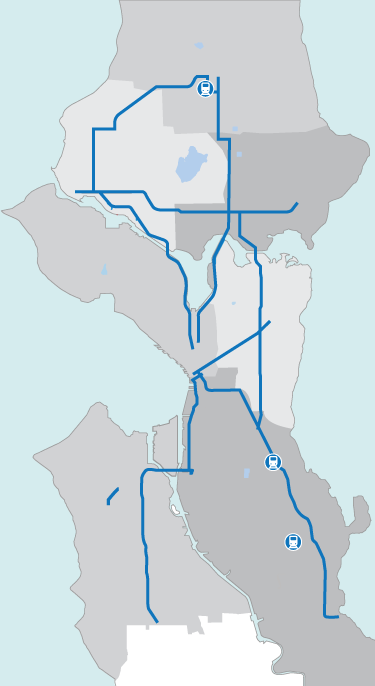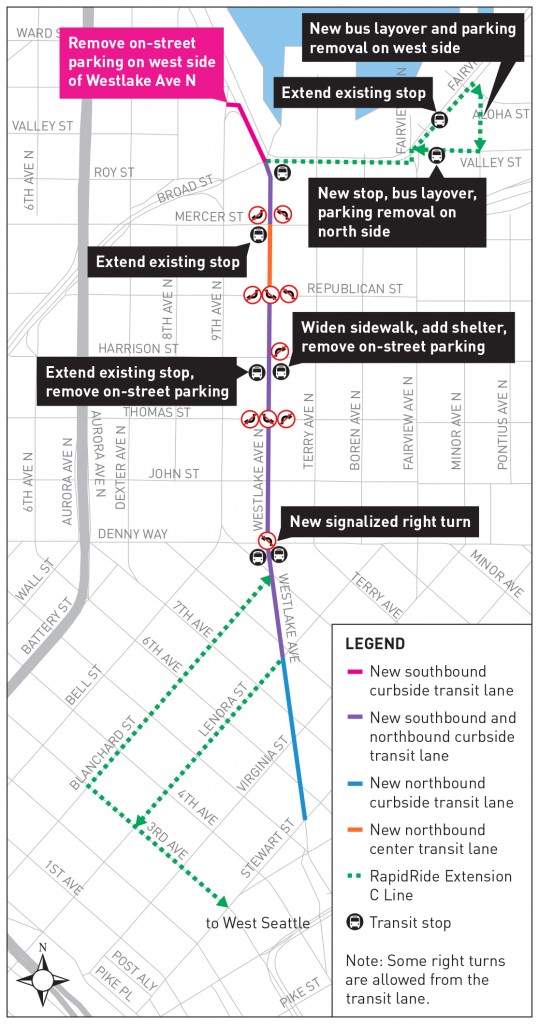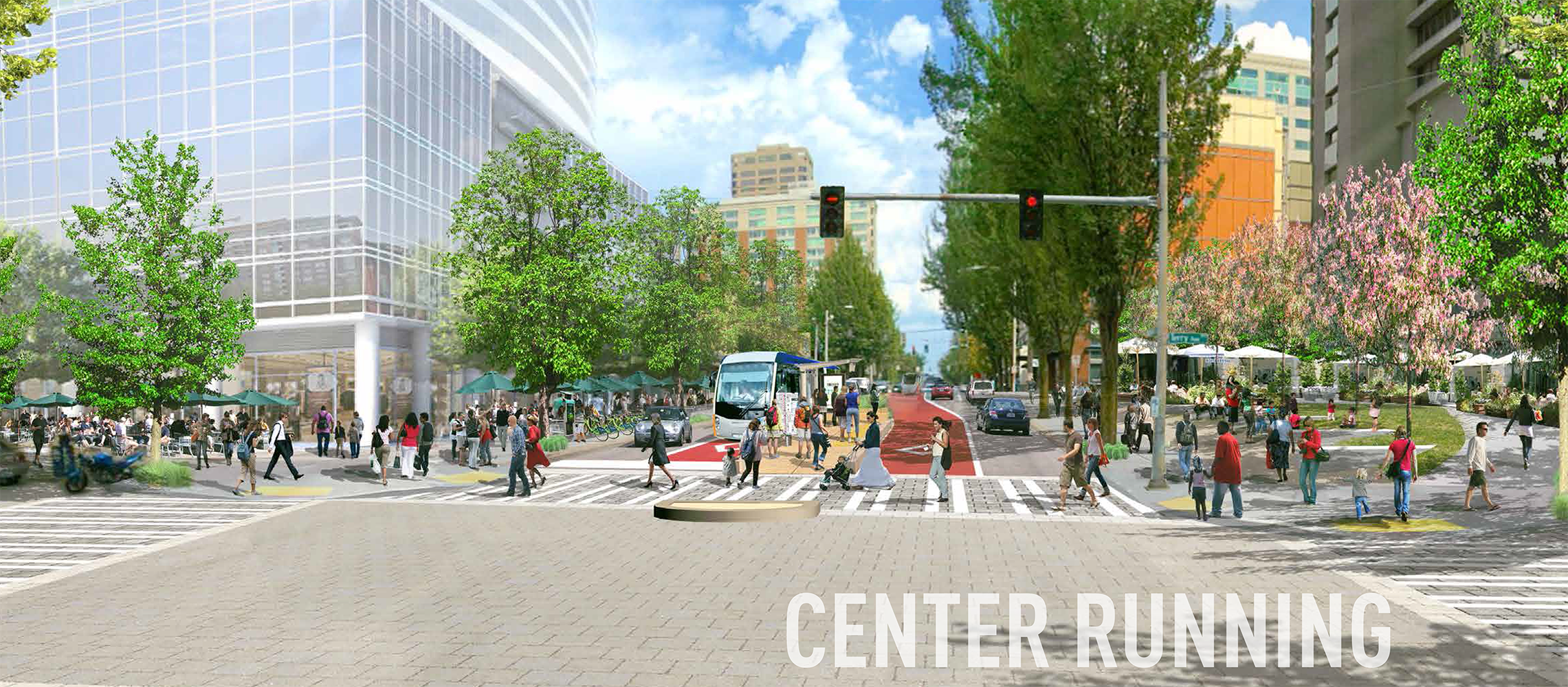I covered the rollout schedule of the next batch of RapidRide+ bus routes. The seven corridors already account for more than 60,000 in weekday ridership according to 2015 numbers. The Seattle Department of Transportation (SDOT) expects the RapidRide+ upgrades to increase ridership by 50,000. Given the existing ridership trend lines and the increase in frequency (SDOT promises at least 10-minute frequencies), that seems easily obtainable and the question really is just how much larger the ridership gains could be.
RapidRide+ Rollout
| RapidRide+ Corridor | Year To Open | Existing Route | 2015 Weekday Ridership | 2016 Weekday Ridership |
|---|---|---|---|---|
| Madison | 2019 | 12 | 3,600 | similar |
| Delridge | 2019 | 120 | 9,200 | down |
| Rainier | 2020 | 7 | 13,400 | slightly down |
| Roosevelt | 2021 | 70 | 4,700 | 7,700 |
| N 45th St | 2021 | 44 | 7,600 | 8,300 |
| Westlake | 2022 | 40 | 9,300 | 11,400 |
| E 23rd Ave | 2024 | 48 | 12,300 | 13,100 |
RapidRide lines have seen steady upticks in ridership since their service upgrades. In 2015, the RapidRide E led all bus routes with 15,800 in daily weekday rides. Meanwhile, the D had 11,700 and the C had 8,300 in 2015, but King County Metro earlier this year boasted of big ridership jumps of 21 percent and 26 percent respectively in these lines. The jump was partly due to lengthening the lines. The C picked up South Lake Union, and the D added Pioneer Square to its route. That was born out in the data they released to the Seattle Transit Blog: The D averaged 14,000, the C averaged 10,100, and the E averaged 17,000 in 2016, thus far.
Overall, Zach Shaner’s analysis of the data dump showed “the net effect of the ULink restructure is an additional 18,800 boardings per day, of which 15,000 are new boardings and 3,800 are bus-rail transfers.” The restructure managed those gains while falling short in some neighborhoods, such as Wallingford and Fremont, that saw bus service reshuffled apparently in the name of feeding Husky Station despite many riders having little interest in transferring to Link at that station for most trips.

Seattle’s bus ridership numbers are impressive for a US city of its size. Recently, the Institute for Transit and Development Policy (ITDP) singled out Seattle for its impressive growth in ridership:
That made Seattle one of the largest all-bus transit systems in the country, until 2007 when the South Lake Union streetcar opened and 2009 when the Sound Transit light rail began. Even still, buses continue to serve as the backbone for the region’s transit, which make Seattle’s rank in the top 10 U.S. metros for transit trips per capita per year all the more impressive. In fact, between 2010 and 2014, Seattle saw the biggest jump in bus ridership of any major US city due to their investments in service improvements.
We have much to be thankful for, especially holding us next to the dismal service in many other American cities. However, Metro Transit should also guard against complacency. A city growing by about 15,000 residents per year lends itself to ridership gains. It can also lead to overcrowding, as many bus riders have reported on the city’s busiest routes. The restructure did prove that greater frequency can lead to greater ridership. The RapidRide+ improvements slated for seven corridors should take that concept even farther and lead to an even greater boost, providing not just ridership gains from a captive market but also gains through enticing new riders with higher quality service in more of the city.
On Madison Street, SDOT opted for a bus rapid transit (BRT) option and may indeed achieve Bronze-standard BRT by my calculations—if things break their way. SDOT predicts 11,400 in ridership on the proposed Madison BRT line, while the current Route 12 is averaging about a third of that. It took $120 million of investment to get Madison into the BRT conversation and based on Move Seattle campaign literature, that leaves about $300 million in leveraged funds to be shared among the six remaining RapidRide+ corridors where improvements are promised in the levy. Due to these monetary constraints, it seems not every corridor is going to get as dramatic of upgrades as Madison Street will.

But some could: Route 40 comes to mind with its big 23% increase after the restructure. RapidRide+ improvements done right could catapult the oft-delayed 40 to the busiest bus line in the system. It’s already near the top. Given the importance of the route, parking for a few motorists on Leary Way NW should not take priority over tens of thousands of bus riders. There is space for BAT lanes in these areas if we sacrifice parking. Meanwhile, dedicated transit lanes on Westlake Avenue were just extended as far north exist as Broad Street. They should extend all the way to the Fremont Bridge, and perhaps beyond.
One thing Move Seattle didn’t promise was improvements to the existing RapidRide corridors. That said, the C and D are promised upgrades in the Sound Transit 3 (ST3) package and will be greatly affected by light rail improvements with the passage of ST3. That leaves the E as the neglected line not slated from improvements in ST3 or Move Seattle despite its bus system leading ridership of 17,000. The city and/or county should locate funds one way or another to put the E’s service to RapidRide+ levels with things like platform level boarding, more efficient stop spacing, and better signal priority. And must we say again: give us a Lower Fremont stop. Strangely, stops are too closely spaced in Shoreline while the line skips its most densely populated neighborhood (East Fremont) in its haste to cross the George Washington Bridge. Adding a 38th Street stop alone would give ridership an ample boost while spreading the E’s benefit more equitably across the line’s neighborhoods.
All this is to say that RapidRide has huge growth potential. RapidRide+ corridors will easily entice 50,000 in additional ridership and probably even more if SDOT plays its cards right and invests wisely. We should see as much dedicated right-of-way as possible to do justice to seven corridors that will see more—and likely much more—than 100,000 in total ridership.
Doug Trumm is publisher of The Urbanist. An Urbanist writer since 2015, he dreams of pedestrian streets, bus lanes, and a mass-timber building spree to end our housing crisis. He graduated from the Evans School of Public Policy and Governance at the University of Washington in 2019. He lives in Seattle's Fremont neighborhood and loves to explore the city by foot and by bike.


